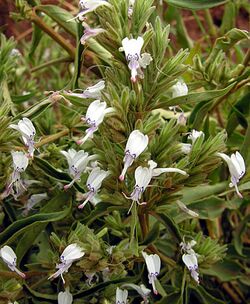Biology:Hypoestes forskaolii
| Hypoestes forskaolii | |
|---|---|

| |
| Scientific classification | |
| Kingdom: | Plantae |
| Clade: | Tracheophytes |
| Clade: | Angiosperms |
| Clade: | Eudicots |
| Clade: | Asterids |
| Order: | Lamiales |
| Family: | Acanthaceae |
| Genus: | Hypoestes |
| Species: | H. forskaolii
|
| Binomial name | |
| Hypoestes forskaolii (Vahl) Soland ex Roem & Schult
| |
Hypoestes forskaolii is an annual or perennial herb that grows up to 1 m (3 ft 3 in) tall with its stem and leaves being nearly glabrous.[1] It has pale pink or white flowers.
Habitat
Hypoestes forskaolii is widely distributed throughout Oman, Yemen, Saudi Arabia and Tropical Africa.[1] It grows under bushes and trees. Hypoestes forskaolii appear during rains or can be seen the year round near water.[2]
Effects
Hypoestes forskaolii is extremely toxic to all livestock. It can be easily eaten in error by animals. When eaten, it produces symptoms of violent shivering, head-shaking and fever. It can be fatal in smaller or less healthy livestock.[2]
Uses
Hypoestes forskaolii has been found to be of interest for containing new sources of antibiotic compounds.[3][4][5]
History
Forsskaolii commemorates the Swedish botanist Pietr Forsskal. He was the botanist on the ill-fated Danish expedition to Arabia Felix (present day North Yemen) of 1761–1763. The aims of the expedition were wide-ranging, and from a botanical point of view, the trip was a great success. Many Arabian plants were described for the first time.[2]
References
- ↑ 1.0 1.1 "Hypoestes forskalei". JSTOR. https://plants.jstor.org/compilation/Hypoestes.forskalei. Retrieved 23 January 2018.
- ↑ 2.0 2.1 2.2 G. Miller, Anthony; Morris, Miranda (1988). Plants of Dhofar. Oman. p. 12. ISBN 071570808-2.
- ↑ Mothana, R. A.; Kriegisch, S.; Harms, M.; Wende, K.; Lindequist, U. (2011). "Assessment of selected Yemeni medicinal plants for their in vitro antimicrobial, anticancer, and antioxidant activities.". Pharmaceutical Biology 49 (2): 200–10. doi:10.3109/13880209.2010.512295. PMID 20942618.
- ↑ Al Musayeib, Nawal M.; Mothana, Ramzi A.; Mohamed, Gamal A.; Ibrahim, Sabrin R.M.; Maes, Louis (2014). "Hypoestenonols A and B, new fusicoccane diterpenes from Hypoestes forskalei". Phytochemistry Letters 10: 23–27. doi:10.1016/j.phytol.2014.06.020. Bibcode: 2014PChL...10...23A.
- ↑ Muhammad, Ilias; Mossa, Jaber S.; Ramadan, Ahmed F.; El-Feraly, Farouk S.; Hufford, Charles D. (1998). "Additional diterpene ketones from Hypoestes forskalei". Phytochemistry 47 (7): 1331–1336. doi:10.1016/S0031-9422(97)00709-7. Bibcode: 1998PChem..47.1331M.
Wikidata ☰ Q17679351 entry
 |

